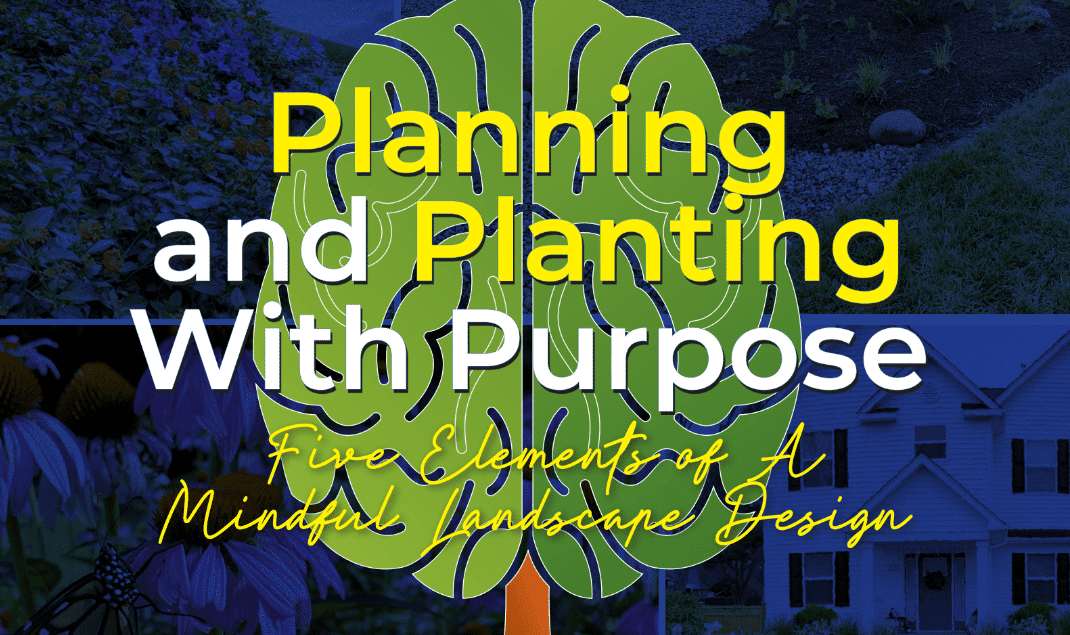
Creating a mindful landscape incorporates the basic tenets of mindfulness: being fully present, connected to your surroundings and intentional about your thoughts and actions. A healthy, vibrant landscape can lift your client’s mood while reducing stress and anxiety. A mindful process starts with intentional planning, attention to detail and encouraging connections throughout the ecosystem.
Monique Allen, owner of the Garden Continuum and author of “Stop Landscaping, Start Life-Scaping,” says that a mindful landscape is a path back to yourself, your spirit and a way to reconnect to your life.
A purposefully designed landscape will bring joy while also enhancing the ecosystem with a thoughtful plan for future growth. It may be a place for meditation, a reading nook or a shelter from the busy world. No matter your client’s definitions of a joyful landscape, there are several unifying elements such as attracting wildlife, selecting pollinator-friendly plants, planning for environmental stewardship, attention to the senses and connection to the mind/body.
These five elements of mindful landscape design can shape the conversation around intention, attention, and connection during the planning process.
Attracting Wildlife
“Never give up listening to the sounds of birds.”
— John James Audubon
Trista Imrich, owner of Wild Works of Whimsey located in Virginia Beach, Virginia, brings nature to her clients by using native plants designed to attract wildlife. She says she loves to hear clients describe their reactions to their newly designed space.

“Clients tell me how they are now paying attention when a new bird or butterfly visits a particular plant and how they love keeping track of the variety of birds that frequent their backyard,” Imrich says. “It brings me pleasure that they are finding the wildlife connection to the landscape around them.”
She relates to their delight in her own life.
“Every few hours I walk around my yard and notice the birds that are passing through, listening to their calls,” Imrich says. “I instantly feel calmer and more focused.”
Imrich guides clients through making choices to create a sustainable habitat that attracts birds, bees, butterflies, and other creatures. She uses a diverse selection of native trees and plants with berries, seeds, fruit, and pollen. Native grasses provide seeds, foraging materials and shelter and a variety of vegetation that’s green and in season all year.
The easiest way to attract birds is to create a space to add bird feeders, birdbaths and birdhouses.
“Always include a source of fresh water for the birds and squirrels — either a birdbath, pond or water feature,” she says.
To consider environmental impact, you may want to include shade trees, evergreen screening for privacy, and native plants to reduce energy input and reduce maintenance. Working with an arborist, Imrich has deliberately left in place a dying tree to provide a habitat for nesting birds, woodpeckers and bees.
Elizabeth Elliott, owner of Himmel’s Landscape and Garden Center, in Pasadena, Maryland, believes the power of connection with nature and wildlife cannot be overstated.
Elliott guides her clients to find a space they are drawn to or focus on a specific area of the yard to make it more inviting.
“I’ve created a bird garden with native plants, feeders and water features,” Elliott says. “And then the client can take it from there. Over time, they can add to the space.”
She says it’s not hard to sell clients on using native plants to attract wildlife and pollinators.
“They want to get on board with sustainability, water conservation and a more natural landscape,” she says.
Purposeful Pollinators
“When one tugs at a single thing in nature, one finds it attached to the rest of the world.”
— John Muir
Intentionally attracting pollinators ticks off all the mindful landscaping boxes. You are part of the solution to the changing pollinator populations, many of which are in decline due to the loss of feeding and nesting habitats. When butterflies, honeybees, moths and birds flourish in a garden, it will delight the senses and create a sense of connection to the natural world.
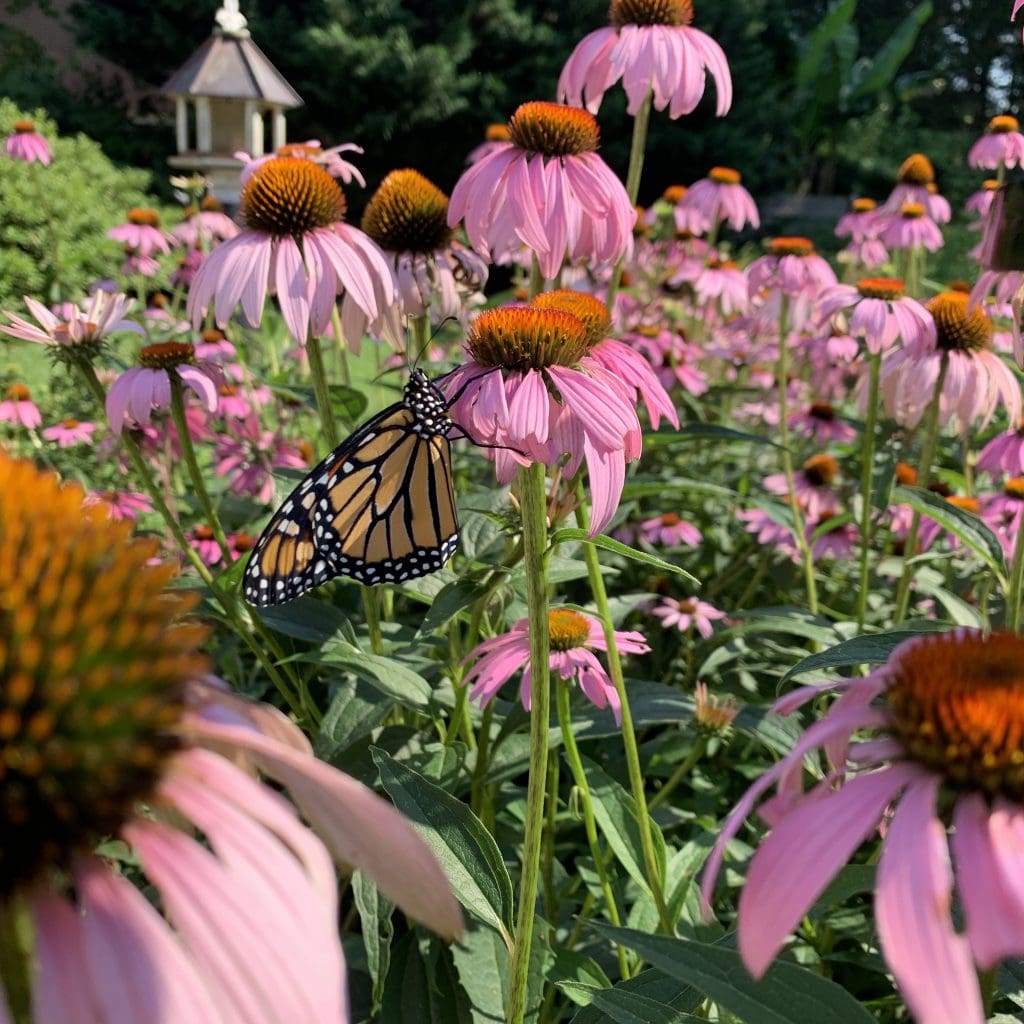
By planting a variety of native plants that bloom from spring into late fall, your client’s landscape can help pollinators find and use the plants. Include larval host plants and nectar in hummingbird feeders. Avoid hybrid flowers that have been bred without pollen, nectar, or fragrance.
Paulita LaPlante, managing partner of Prescription Landscape, operates a commercial landscape design company in St. Paul, Minnesota, and specializes in bringing sustainable, healthy landscapes to commercial campuses and corporate sites. While commercial installations are more of a challenge to approach with a mindful, holistic approach, a recent project led by the lead account manager, Teddy Paterson, is an example of presenting a thoughtful, functional plan for a corporate office landscape.
“We are proud of our role in promoting native pollinator gardens,” LaPlante says.
The project was extremely challenging. After going remote during the COVID-19 pandemic, the client wanted to bring back more than 1,000 employees to work in the office. They realized they needed to upgrade the overall look and feel of the workplace, including the outdoor area where most employees congregate.
But that area was an eyesore infested with invasive/noxious plant species. Paterson considered various solutions and ended up proposing a native plant pollinator garden. His plan included replacing the invasive plants with an arrangement of native plants selected for vital pollinating insects and birds.
Paterson is passionate about pollinators and knew he could create an inviting place for employees to gather while educating them on the value of pollinators. To that end, he worked with the ad/marketing team to create signage describing the plants and their function in providing food and habitat for pollinators and reversing their decline, especially bees.
“We are ‘pollinating information,’” Paterson says. “You will see purple cone flower, and the sign will teach about its connection with a pollinator. The hope is that we are taking a thorough approach. My intent isn’t to just sell pollinators. If the employees are reading the signs, they are increasing their knowledge about connecting with the local ecosystem and beyond.”
LaPlante believes that a mindful landscape is intentional and draws attention to details. That’s why she calls Paterson’s project an example of gorgeous thoughtfulness.
“If you understood more about the ‘why’ of these plants, you would be more protective of them, and understand them,” she says.
Attention to the Senses
“As I work on the garden, the garden works on me.”
— Gayla Trail
Daria Paxton, owner of Gaia Gardens in Essex County, New Jersey, named her landscape company after the Greek goddess of earth, mother of all life. She says she loves that Gaia describes how Earth is analogous to a single system where everything is connected, and nothing happens in a vacuum. She believes a mindful landscape that’s created with intention can delight all the senses while being functional and solving problems. One of the most powerful features of a sensory garden is planting for nostalgia.
“My grandmother’s peonies, the smell of jasmine, all connect me to strong memories,” she says.
Here are some ways to plant for a full sensory experience.
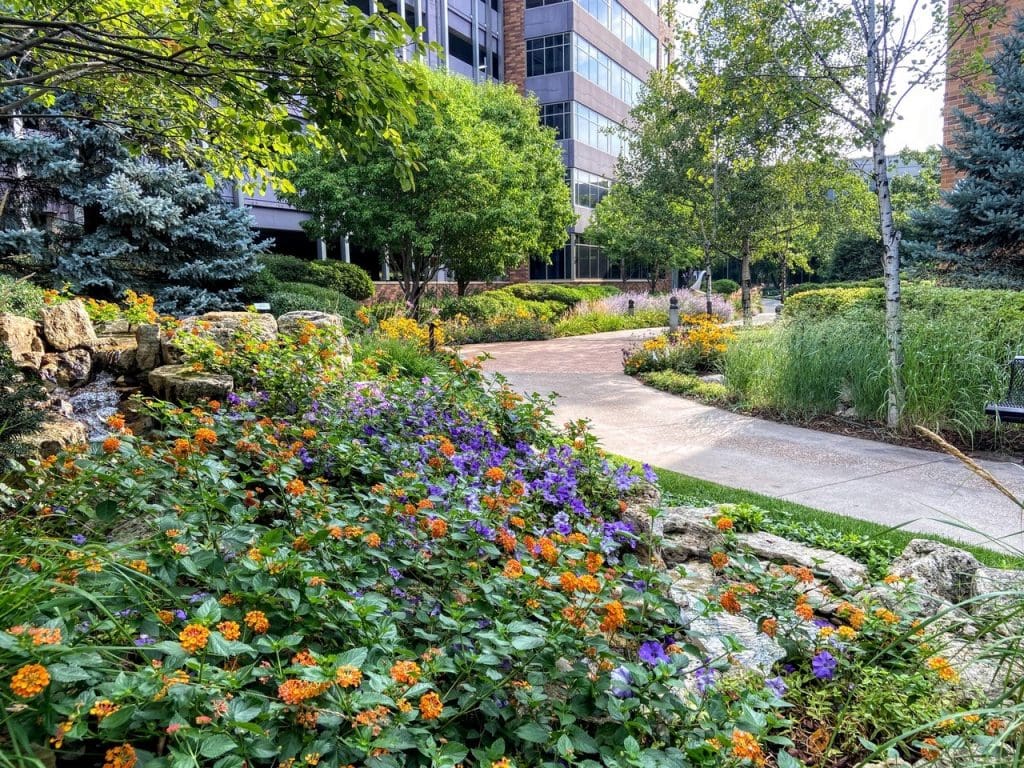
Sight: Choose plants for their color and appearance to make a strong visual impact. But Paxton says it’s not just the plant choices but how those plants are arranged. She guides her clients to choose the best way to display color.
Her art history background comes into play when talking about straight lines and clean uniform gardens inspired by Dutch artist Piet Mondrian, known for his colorful geometric paintings versus Jackson Pollock’s impressionism. Paxton says it’s trendy to have straight lines and low-maintenance, clean landscapes. Her personal preference is more of a “riot of chaos” with careful planning for the most impact.
“No clients ever ask for a ‘high-maintenance plan,’” she says with a laugh.
But, over time, a soothing mindful garden may attract them to become more involved with their landscape.
Sound: When a plan includes attracting wildlife and pollinators, the benefits include the sweet sound of birds calling, squirrels scampering and the gurgling of water features. Other ways to incorporate sound can come from the crunch of a gravel walkway, the rustling of leaves from mature trees and the buzzing of bees.
Taste: It’s easy to add savory and sweet edibles with an herb garden that’s either incorporated into the garden or in decorative planters. Nostalgic plants like tomatoes and basil can connect clients back to their childhood.
Smell: Fragrant lavender, roses, honeysuckle, gardenias, and fruit trees not only smell wonderful but attract pollinators. Healing gardens incorporate smells like lavender for calming and invigorating ones like rosemary and aloe vera.
Touch: Outfit a garden with different layers and textures that make clients want to touch the flowers and leaves. Plants such as the fuzzy, soft Lamb’s Ear; fuzzy buds of a Magnolia tree; lacy, airy foliage of dill and fennel; and the various textures of tree bark all add the element of touch. Children are especially taken with touching the leaves and flowers and learning words to describe their texture.
Environmental Stewardship
“You can’t force people to care about the natural environment, but if you encourage them to connect with it, they just might.”
— Jennifer Nini
A focus on water conservation and wastewater management are two ways to solve problems within the landscape while also contributing to solutions for the whole ecosystem.
Imrich’s company is in the Chesapeake Bay watershed, and she’s acutely conscious of her mission as a steward of the environment — especially when it comes to stormwater management. Because her location is surrounded by water, the water is either coming in or going out and, in some areas, the land is sinking when the water doesn’t have anywhere to go. When she walks through a space, she’s looking at ways to solve problems with stormwater management.
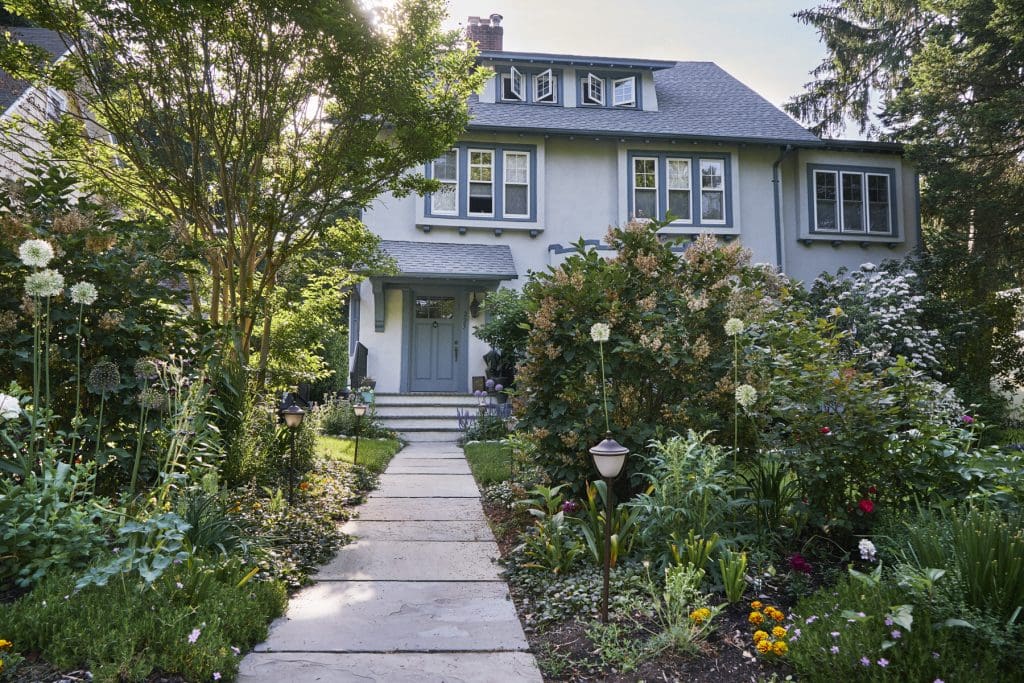
“You have to be mindful of what is happening with the water, pollutants running off, deluges of rain and storm drains backing up,” she says.
All thoughtful plans should include water conservation. Imrich will use native plants that have more fibrous roots as well as install rain gardens and rain barrels to catch and temporarily hold rainwater. Other options include installing permeable pavers, berms, and healthy plant cover, especially on slopes, to help prevent erosion.
“I don’t want the efforts to look over-engineered,” she says. “Instead, I try to blend the stormwater solutions into the landscape.”
For arid areas, consider xeriscaping to create water-efficient landscapes. This basic design principle means grouping less water-dependent plants together to reduce watering and fertilizing, improving soil conditions. Increasing the use of mulch, decreasing turf, using native grasses and ground covers and planting shade trees are other basic principles of xeriscaping.
Shifting Mindset
“Embrace the impermanent nature of nature.”
— Monique Allen
When Monique Allen, with Garden Continuum in Medfield, Massachusetts, talks about mindful landscape design, she begins by shifting the thinking from mindlessly collecting landscape features to intentionally designing for an enhanced life. In her book, “Stop Landscaping, Start Life-Scaping,” Allen lays out how to move from thinking about the landscape as a “thing” to a more dynamic, interactive status that takes time and patience to reveal itself.
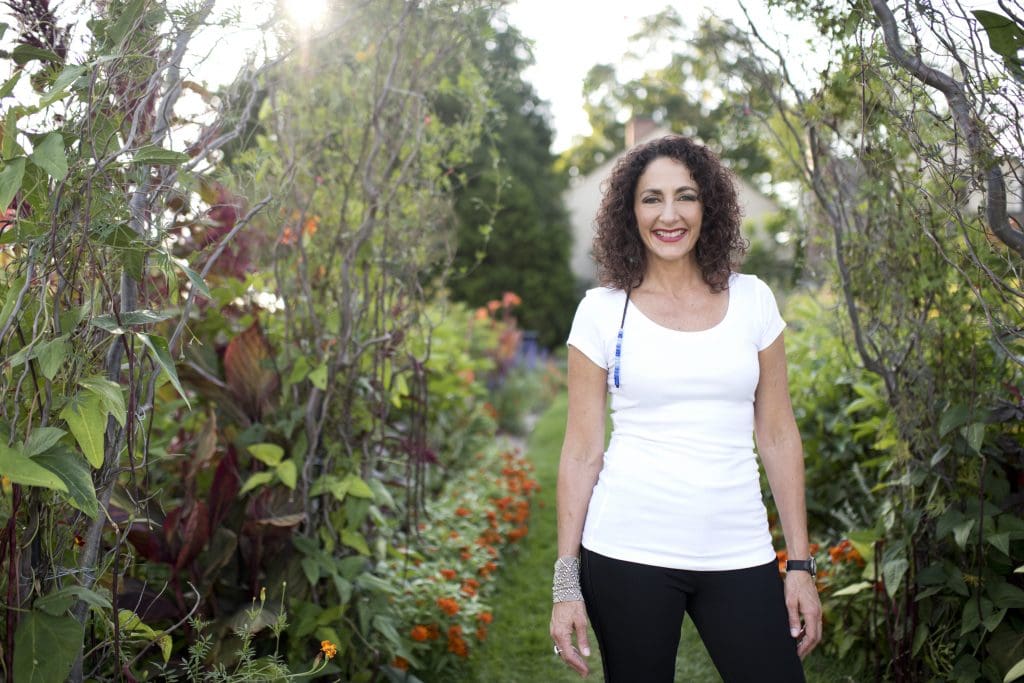
She describes three key elements — organized, healthy and WOW factor — to achieve a beautiful, harmonious space that’s part of a complex, integrated ecosystem she calls “Life-Scapes.”
Organized: Create a thought-out intuitive design that will show where to park, walk and play with each space flowing effortlessly from one to another in a logical and comforting way.
Healthy: Healthy plants are lush and green, not painfully sheared into shapes or overgrown and swallowing up the structures. This is achieved with good soil, water management and conservation and using organic materials and native plants that don’t require much to thrive.
WOW! design: You see it and it makes you stop and picture yourself in the environment, imagining how you would fit in, use the space and flourish. It turns heads and vibrates joy.
If pressed to pick one of the three, Allen says she would go with healthy.
“If the plants are healthy, it is safe and can tap into the most cynical of thinkers if you are in it long enough,” Allen says. “The human psychology is wired to be drawn to health. The healthy plant is a feature of the ecosystem, so you are connected to overall ecological wellness by creating a healthy garden.”
To achieve her Life-Scape concept, she says she’s a strong advocate for helping clients consider the long game. This is the opposite of the HGTV world of templated gardens and instant gratification.
“You need to allow the dream to happen, the planting process, construction process, take your time, understand that when the landscape is done, it’s not done,” Allen says. “It should never be thought of as static, set pieces you buy, build and be done with.”
“A mindfully created project is not a thing but a process,” she says. “Low maintenance is earned, and health is an investment.”
Her advice may flow in a different direction than the current narrative, but she says it’s worth it to guide clients by moving them into a more mindful design that ultimately helps them find themselves.
This article was published in the May/June issue of the magazine. To read more stories from The Edge magazine, click here to subscribe to the digital edition.

